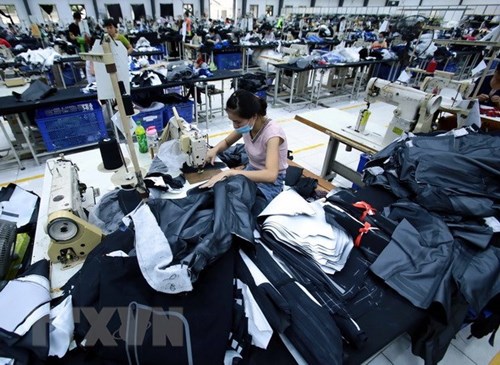VITAS Chairman Vu Duc Giang said although the Comprehensive and Progressive Agreement for Trans-Pacific Partnership (CPTPP) and the EU-Vietnam FTA (EVFTA) have yet to come into effect, they have significantly helped attract foreign investors in Vietnam’s garment-textile sector.
Importers of Canada, Australia and New Zealand have no longer focused only on China but turned towards Vietnam, he said.
    |
 |
|
By the end of 2017, Vietnam had attracted 2,079 projects in the garment-textile sector with total capital of USD 15.75 billion, up 10 percent year-on-year |
The increasing number of orders from foreign firms has wooed investment in the production of materials in service of the industry. Apart from Ho Chi Minh City, other localities like Hung Yen have lured the attention of FDI firms, he noted.
However, most Vietnamese garment-textile enterprises are small- and medium-sized with low competitiveness due to limited investment, according to Giang.
Few of them such as the Vietnam National Textile and Garment Group (Vinatex) and Corporation 28 (Agtex) have the capacity to compete with FDI rivals, he said, adding the content of Vinatex’s locally-made materials exceeds 50 percent and many of its yarn and dyeing projects have been put into operation.
According to VITAS, garment-textile production lines and orders have been moved from China to Vietnam as China has lost its advantages in terms of labor costs. Besides, Vietnam’s joining many FTAs has not only created opportunities for local businesses to diversify its export markets but also attracted material suppliers.
Once the CPTPP becomes effective, it is expected to increase Vietnam’s exports to CPTPP member countries whose accumulated annual import turnover amounts to USD 40 billion, said Giang.
Le Tien Truong, Vinatex General Director, said one of Vietnam’s attractive factors to foreign investors is low-cost labor.
Statistics show that by the end of 2017, Vietnam had attracted 2,079 projects in the garment-textile sector with total capital of USD 15.75 billion, up 10 percent year-on-year.
The investors come from 57 countries and territories nationwide, with major ones from Taiwan and Hong Kong (China) and the Republic of Korea (RoK).
In the first six months of this year, up to USD 2.8 billion in FDI was injected into Vietnam’s garment-textile industry, Truong said, citing some large-scale projects like USD 80 million Nam Dinh Ramatex Textile and Garment Factory of Singapore’s Herberton Ltd and Ha Nam YKK Factory specialized in producing zippers and other materials for the garment industry with an annual capacity of 420 million products.
According to Giang, Vietnam’s garment-textile export revenue is projected to reach USD 200 billion by 2035.
Given this, he suggested the Government and the Ministry of Industry and Trade outline a strategy for the sector by 2040 and a planning schedule for garment-textile industry parks that meet international standards of waste treatment.
Domestic garment-textile businesses should fully understand regulations of the CPTPP and EVFTA to utilize the benefits of the agreements, he said.
Source: VNA